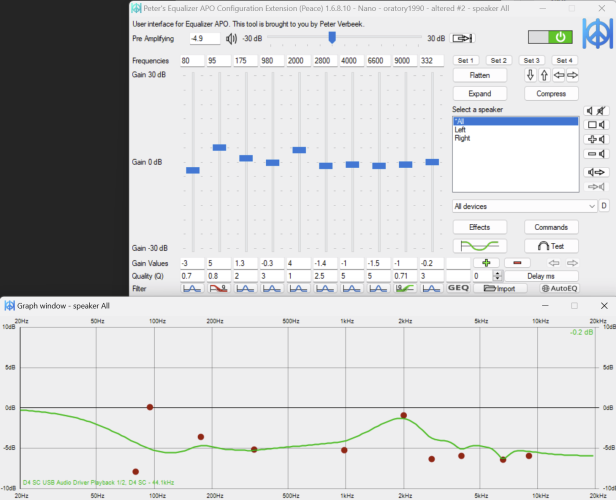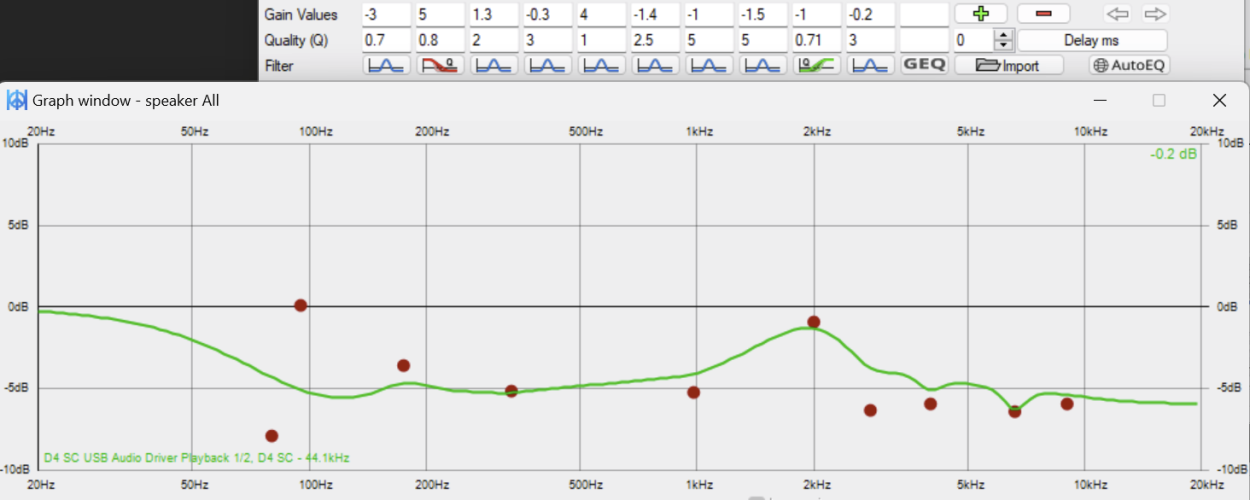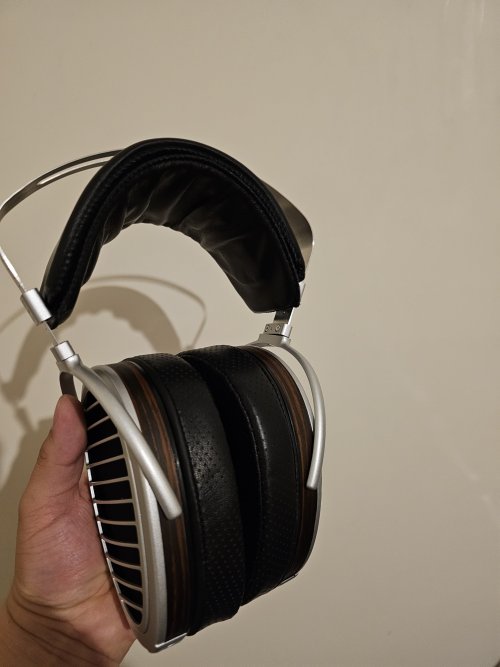So cool! I'm curious, what is it about the nanos that made you want to spend the money having them professionally EQ'd and, I guess, use them as your professional environment working headphones?
And also, with what you said, I wonder if the difference between what you are using as a reference and what I am leaning towards is because of the relative lack of treble energy?
I've been swapping and swapping between your EQ settings and one I had made previously, and I just feel like there is so much information missing. The reference one you had listed sounds almost...like an old radio? to me. Almost kind of hollow. I feel like there's so much detail that's not there.
I've tried it with so many different kinds of music - operatic solo + strings makes it the most apparent.
As you are an audio engineering professional, I'm just wondering what you think?
That's the curve I've been using. I do think yours is maybe easier to listen for a longer time though? Perhaps it's a lack of skill in critical listening on my part?
What really stood out from other “reference” cans I have is their ability to transmit transient and decay like I’ve never heard of in any other headphones in my life. I started sparely using cans in 2008 or about. First it was the Sony MDR7506 (for their availability in the studio I was working at and wanted to do some personal project while my session were over) then a few years later I got the Q701. Both had huge flaws but you grow to learn them and work with them until you reach their limit of reliability. Then I got the HD650 and it was a revelation in the high mids as it was almost just like working on my near fields and it was almost spot on when I check for translations on other devices. The issue was mid lows and bass translations. It was always on and off. Some good, some bad. I’d never know if I had enough instrument separation or if I should work more to create space in the mid lows or if my mix were anemic. So I started using a correction EQ to boost my lows but all it did is bring up the noise floor and the distortion with lows and it barely change anything in my capacity to judge the mid lows and the bass region. At that point in time, cans were only a second order tool. Cool to have but unreliable. Fast forward to last year , I got a few contracts offered to me while I was in my yearly trip in Colombia by some artist/manager/ label I’ve worked with In the past. I told them about my situation and that I only had very bad monitoring solution in hand (mpow x3 Bluetooth earphones) but they insisted so I started composing and they sent a few tracks to get mix. I then flew down to a neighbouring country and brought some stuff I composed and mixed so we could talk and readjust and when they heard my new stuff, they were all blown away….. and so was I. I was not expecting that sort of quality in my mixes but it all worked out very well. Fast forward to this past April, I got back to Montreal and decided it was time to give earphones a fair shot so I bought the 64 audio U12t. Boy was I disappointed. The ear insertion was unmanageable which in return gave me good to bad frequency translations. Decided to sell them and went on a serious hunt. So I got the Slate VSX, a headphone and room software package that suposedly replicate high quality studio environment and their respective monitors. The room sounded reverberated and even a set of PMC IBS sounded bloated. Put them aside. Started reading on gearslutz about how the NDH30 was a game changer . Bought them. Was very disappointed by their detail retrieval. Put them aside. My goal was to get something that would be transient friendly with an half decent frequency response and some details in the mid lows and bass. I was chatting with another user in a different forum and he told me about that Turkish electronic music mastering engineer that sweared about the new Ananda Nanos. Started listening to his last records and thought they sounded great but a bit too bright. So I took a plunge and got them. When I received them, everything I was looking for was there. At first, I was like you . I wanted more of that treble but then figured something was off with the mids and the vocals always sounded a bit in the back. I thought to myself , well, let’s have them measured and be off with it. So 400$ later and about 10 days of patiently waiting, I received them. When I first got them, I had the impression that some treble details were missing but I then started to pay attention and really, everything was there. Not only was it there but it was also very prominent and what should have sounded harsch in my mastering monitors still sounded harsch on my nanos.
That’s when the whole quest and inside pressure of finding a decent set of cans to work this winter went off .
Your impression of the curve I created for you is not really a surprise. See, there’s a difference between listening for enjoyment and listening critically. As such, a Marvel movie will definitely not be translating the same way as ( to bring our friend in this conversation) a bjork movie would sound.
There’s thousands of example that I could bring to your attention so you understand the worth of a balanced frequency response. In reality, all that will ultimately matter is your ability to make the difference between an old radio and a flatter frequency response.
A smiley curve is absolutely nothing bad if that is what you love but as I understood your post, you seem to be a classical music lover which lead me to believe that you are missing so much of the natural experience of the instrumentation by favouriting trebles and bass over the strings , brass and pianos fundamental area .
I know I said it before but I would try to make a reset in my approach of listening to music if I was you. It will not only benefit your ears health but also get you to discover a lot more subtleties. Especially in classical music as it really all lives in the mids. If you cannot ear it, train yourself and find resources to help you understand what to listen for.
Air, space, sparkle and big bang boom are cool but music harmonies and charming swinging waves of frequencies live in the mids. I’d say, try to rediscover music in a different way.
You have a wonderful detailed and resolute set of cans in the nanos in hand. You can afford to cut back on the cocaine frequencies and go get the good stuff in the mids.
Hope that help.
































